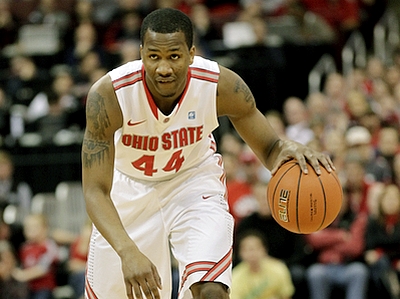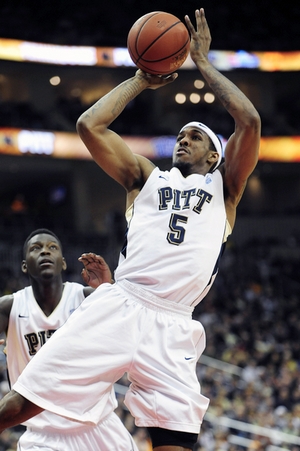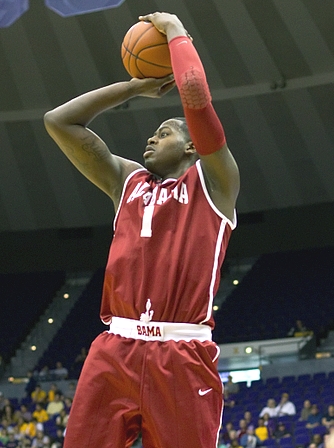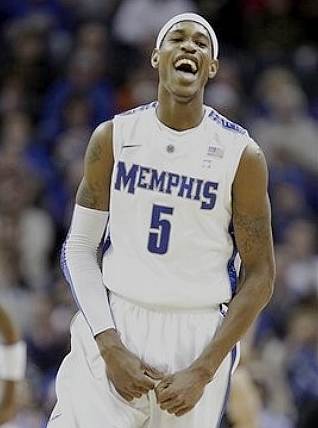14.3 Points, 3.8 Rebounds, 3.1 Assists, 1.8 Turnovers, 47.4% FG, 43.9% 3P, 85.5% FT

Matt Williams
When we last checked in on William Buford, we noted that versatility and perimeter consistency would play a big part in his development as a prospect this season. A somewhat one-dimensional, but not overly efficient, shooter in his first two seasons at OSU, Buford has taken a big step forward on a number of levels as a junior.
Though he's scoring fewer points that he did last season and has seen his raw production drop across the board, Buford has carved out a clear role for himself that seems consistent with what he'd be asked to do in the NBA, and has shown some new wrinkles in his game that bode well for his future.
The development of Buford as a role-player is very significant because of his lack of elite NBA physical tools. Lacking great size, strength and explosiveness, Buford has never shown the ability to regularly make dynamic plays around the basket. He hasn't gotten to the line at a high rate in his college career, is just an average finisher, and has relied primarily on his perimeter game to score.
Sporting compact form on his jump shot, Buford earned a reputation as a shot maker on the high school level. While he's had his share of hot shooting games over his three year career, the junior has taken a major step forward in terms of efficiency. Knocking down just 41% of his catch and shoot attempts and a meager 33% of his pull up jumpers last season according to Synergy Sports Technology, Buford is connecting on 44.7% of his shots with his feet set and a blistering 44.1% of his shots off the dribble this year.
Much of that improvement is the byproduct of upgraded discipline and maturity. Playing next to two other capable perimeter scorers in David Lighty and Jon Diebler, Buford's decision-making has been exceptional this season. He'll blaze the nets when he's left open, will try to create room for his pull-up jump shot when his team needs a big basket, and gives the ball up unselfishly when he sees an open teammate. Though Jared Sullinger garners much of the national attention for Ohio State's success, Buford's play has been an incredibly important factor as well.
Not only has the Toledo native been more efficient in his role as a spot-up and off-screen scorer, he's seen a higher percentage of his touches in pick and roll situations. Showing an improved floor game and feel for scoring from the midrange, Buford's overall offensive usage has decreased, but he's doing substantially more with less. He's proven capable of scoring efficiently in a number of situations, and does a lot of things NBA teams like to see from role-players at his position. He has developed a nice spin move off the dribble that allows him to get his shot off in one-on-one situations, and while he's still not a pure isolation scorer, he's more capable of creating his own shot than he was early in his career.
Buford has also made some strides on the defensive end this season. Similar to his limitations offensively, he is not a great one-on-one defender. He lacks great strength and lateral quickness, but works hard to get over screens, stays in a good defensive stance, doesn't take many risks, and plays within a team concept. With Ohio State going away from many of their zone defensive concepts this season, Buford has shown both his strengths and weaknesses at the defensive end.
Ohio State will be amongst the most watched teams by NBA decision-makers in March, meaning Buford will have ample opportunity to show his wares on college basketball's biggest stage. If he continues to perform at a high level, he has the potential to continue making his way up draft boards. Whether or not he will declare for this draft remains to be seen, and he was quick to announce his intentions to return to school after rumors of his early entry circulated last season. Though Buford may not have star potential, he looks more and more like a serviceable NBA two guard and is a player worth keeping tabs on throughout March Madness.
Gilbert Brown, 6-6, Senior, Shooting Guard/Small Forward, Pittsburgh, 11.1 points, 4.4 rebounds, 2.9 assists, 1.8 turnovers, 44.6% FG, 40.2% 3FG, 76.3% FT

Kyle Nelson Gilbert Brown emerged as a legitimate NBA prospect after a solid junior season and he has continued to play a vital role for Pittsburgh Panthers as a senior.
At 6'6 with a long, 200-pound frame, Brown looks the part of an NBA player. He is a good athlete, as well, both explosive around the basket and quick in the open floor.
While Brown was never a particularly productive player to begin with, his scoring rate and shooting percentages have both decreased during his senior season as his minutes have risen, to the tune of 16.7 points per 40 minutes pace adjusted on 44.6% FG.
Brown plays a complimentary role on one of the most efficient offenses in college basketball, where over one-third of his offensive possessions are created for him in the form of spot-up opportunities. He has shown marked improvement as a shooter, shooting a a career-high 40.2% from beyond the arc on nearly five attempts per 40 minutes pace adjusted. His mechanics remain awkward and he is still most effective shooting with his feet set, but he has improved consistently throughout his collegiate career and he definitely has potential to play a role with his spot-up perimeter shooting ability at the next level.
Brown has not developed his shot-creating ability very much this season, something he likely won't be expected to do much of in the NBA. He's getting to the free throw line a bit less this season, and is not very efficient operating inside the arc. Just an average ball-handler at best, he tends to settle for mid-range jumpers in lieu of attacking the rim, which has caused his 2-point conversion rate to drop from 54% to 49% this season.
Though he is limited as a scorer at the collegiate level, Brown compensates by displaying excellent intangibles on the offensive end. He is a willing passer and teammate, exemplified by his career-high 1.60-assist/turnover ratio. Furthermore, he knows his limitations as a player and he rarely forces anything on the offensive end.
He is equally steady on defense, confirming his reputation as one of the most effective and versatile defenders at the collegiate level. He is a very good one-on-one defender and his quick hands, length, and excellent lateral quickness allow him to stay in front all but the quickest collegiate guards. With his ideal physical tools, toughness and college pedigree, there is no doubt that he has the potential to develop into an elite defender a the next level.
Though he will be 24-years-old by the start of the NBA season and there are question marks regarding whether he can consistently make NBA three-pointers with his awkward mechanics, Brown remains an intriguing prospect whose niche as a pro is already well-established. His intangibles and defensive abilities will certainly translate to the next level and, if he can continue to distinguish himself as a reliable spot-up shooter during the NCAA Tournament and Pre-Draft process, then there is a good possibility that he will find himself on a NBA team.
JaMychal Green, 6-8, PF/C, Junior, Alabama
15.9 points, 7.5 rebounds, 1.7 assists, 2.2 blocks, 1.4 steals, 2.8 turnovers, 49% FG, 73% FT

Joseph Treutlein
Steadily improving his production his three seasons in college, JaMychal Green has established himself as a very good college player, now the leading scorer on the best team in the SEC West. Scoring in double figures in all but one of his games played this season, Green has been very consistent in what he does well, but will it be enough for the NBA level?
Profiling his offensive game, Green is still mostly the same player we've analyzed the past two years, a gritty inside player skill set that is still coming along in polish. Standing 6'8 with a good but not great athletic profile, Green does most of his damage within five feet of the basket, where he fights consistently for inside position and has no problem throwing his body around and finishing through contact.
Looking at his post-up game, Green is extremely reliant on a right-handed hook shot, a shot he has a high release point on due to his excellent length and can finish somewhat reliably out to 8-10 feet. His touch is pretty good overall, but he struggles with accuracy when rushed, and isn't the most instinctive player, lacking much in the line of counter moves.
Finishing off the ball, Green does an excellent job at the college level, excelling greatly when left open or when matched against smaller frontlines, having no problem elevating and finishing with power when he has the time to gain his momentum. Things get a little more complicated when he is in tight spaces and/or up against NBA caliber athletes, however, as his lower body strength is still underdeveloped and he needs time to gather himself to fully explode. This could be very problematic for his skill set projecting to the next level, and maximizing his physical tools needs to be of the utmost priority.
The biggest thing Green lacks at the moment is a reliable perimeter game, somewhat strange given his solid free-throw shooting, as he's hitting for 73% from the line on a very solid 6.0 attempts per game. Green actually looks very comfortable when he has the time to get off his shot, but struggles heavily when contested, where his mechanics break down and he gets very sloppy with his release. According to Synergy, Green is hitting for just 0.42 points per shot on guarded jumpers compared to 1.00 points per shot on unguarded jumpers, which clearly illustrates the problem. Working with a shooting coach to develop a higher comfort level in those guarded situations will be critical for Green, and it's something well within his capabilities to do.
On the defensive end, Green is somewhat of a mixed bag, on one hand being a very good college defender overall, but showing some warning signs when projecting to the next level. In the post, Green does an excellent job using his length to contest shots, showing great timing blocking shots in both man and help side situations. Green is prone to being beat in a variety of ways, however, being backed down by stronger opponents and beaten laterally by quicker opponents, making it very questionable how he'll be able to match up against NBA power forwards. His length and activity level are definitely in his favor on this end, though, as evidenced by the numbers of blocks and steals he grabs per game.
For a player with Green's physical profile and somewhat limited offensive skill set, his just average performance on the glass is also concerning, with him pulling in a respectable but not exceptional 10.7 rebounds per 40 minutes pace adjusted.
To succeed at the next level, Green will likely need to shore up his abilities on defense, the glass, and with his mid-range jumper, three things often relied upon by role playing bigs. As a good but not great athlete standing 6'8 without an outstanding offensive skill set to rely on, Green will likely need to make his living doing all the little things, which he already does adequately well but will need to do better. Just a 20-year-old junior who's subtly improved in his three seasons, he still has time to grow as a player and will have plenty of chances to show his merits.
Will Barton, 6-6, Freshman, Shooting Guard, Memphis
12.6 points, 4.8 rebounds, 2.8 assists, 2.6 turnovers, 1.3 steals, 44% FG, 70% FT, 28%3P

Walker Beeken
As the ninth rated player in the Class of 2010 RSCI rankings, Will Barton came into his freshman year at Memphis as the leader of a highly touted recruited class for Coach Josh Pastner. So far this season, Barton has displayed the physical gifts and talent that make him an intriguing prospect, but he's also shown that he still has a ways to go in terms of refining his skill set and learning how to play efficient basketball.
It doesn't take long to notice Barton on the basketball court, as he looks the part of an NBA shooting guard prospect. Standing at 6'6 with long arms and a thin frame that should continue to fill out as he gets older and puts in time in the weight room, he also has the prototypical athleticism that scouts like to see with great speed, quickness, and elevation.
Much of what we've seen from Barton in his first season at Memphis is similar what we last wrote about him while at prep school. While he makes some spectacular plays on the offensive end and shows good shot-creating ability, he also has a tendency to force the issue, which makes him far less efficient than he's capable of being if he can learn to pick his spots.
At this stage, Barton shows flashes of becoming a decent shooter from the perimeter, but his shot selection can be absolutely terrible, as it seems he doesn't have any ability to differentiate between a good shot and a bad one.
He's scoring over a point per shot on catch-and-shoot jumpers so far this season, but his efficiency drops significantly to .56 points per shot off the dribble, which unfortunately make up over 40% of his jump-shot attempts. Barton is only making 28% on his 3-pointers, which illustrates how far he still is at this point from reaching his full potential as a shooter. His form looks fine with his feet set, so if he can tighten up his shot selection and put in the work to become more consistent, he projects to be at least a respectable perimeter shooter at some point down the road.
Barton is clearly most comfortable in a faster paced game when he can get out in transition. He has great speed with the ball in his hands or filling the lanes, and he's able to get to the basket and elevate to finish or dish off to a teammate on the break. He still struggles with his decision-making at times and throws sloppy passes and pulls up for unnecessary jumpers, but his talent is evident when he's in the open court.
In the halfcourt, Barton has the ability to get into the paint regularly off the dribble, utilizing his explosive first step and rangy strides, but his slashing game still lacks quite a bit of polish. He frequently has tunnel vision as he's driving to the basket, his handle is loose, and he too often bails out his defender by settling for jumpers. And while his underdeveloped frame prevents him from finishing around the basket at times, he does have good elevation, body control, and an array of shots at the rim that project well for him going forward.
Defensively, Barton shows quite a bit of promise, thanks to his excellent physical tools. He still needs to get stronger, but his combination of length and athleticism should enable him to be the type of player who could defend multiple positions, depending on the matchups. He puts a solid effort in, but isn't the smartest defender at this stage, often reaching and getting caught out of position, leading to him getting beat by his man. Increasing his focusing on this end of the floor on a consistent basis would really enhance his effectiveness.
When looking at Barton's NBA draft prospects, it's clear that his physical attributes and natural talent make him an intriguing prospect for teams to evaluate. Being that he was a fifth year prep player and is older than most freshman (he turned 20 in January), he may be tempted to leave school early based on preliminary rumblings.
The 2011 draft looks to be weak at this stage and could be especially thin at the shooting guard position, but at this point, Barton would still likely be looked at as quite a risk by most teams. He hasn't produced at a very high level this season, and he lacks the polish and feel for the game necessary to make any team believe that he could contribute anytime in the near future. Simply put, teams might not have the patience and playing time needed to develop him, and there's a good chance that he could slip between the cracks if he isn't careful.
Should Barton decide to remain in school at Memphis, he's certainly a player that we'll be watching closely, as he has the potential to really boost his draft stock if he puts in the work. He'll have more time to improve his decision-making, refine his skill set, work on his body, and show teams that he's capable of fitting into a winning system, which could ultimately earn him quite a few fans amongst NBA scouts down the road.
LaceDarius Dunn, 6-4, Senior, Guard, Baylor, 20.4 points, 4.1 rebounds, 2.3 assists, 3.5 turnovers, 41.9% FG, 38.7% 3FG, 83.2% FT


































Comments